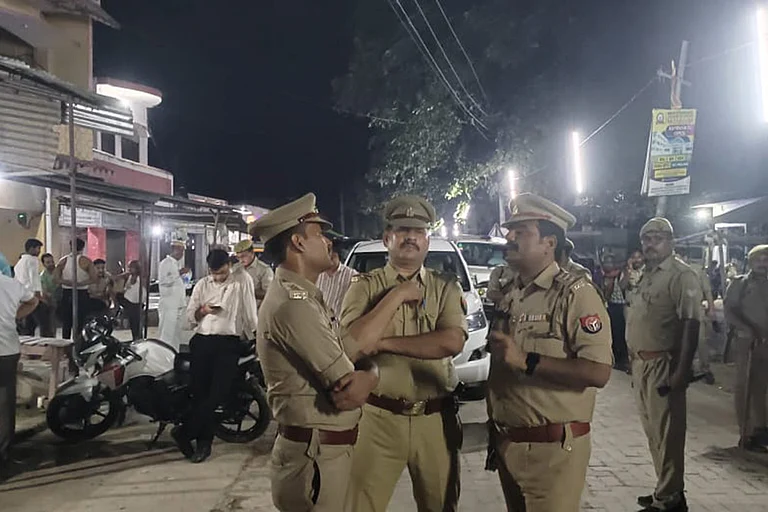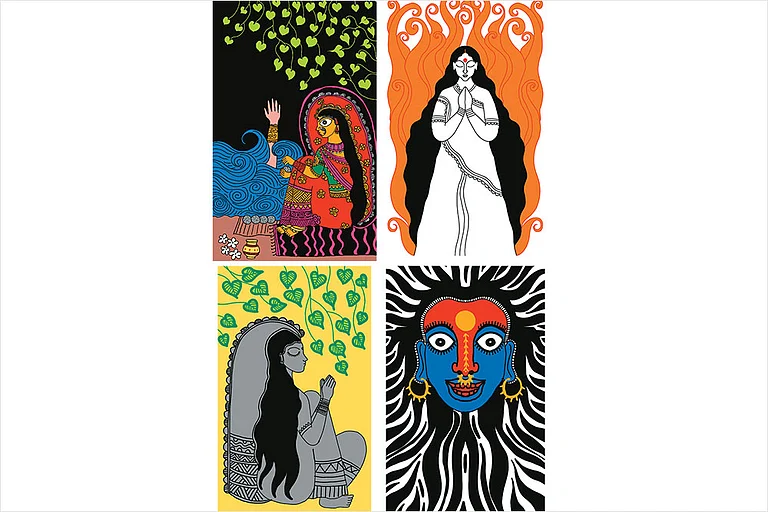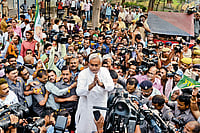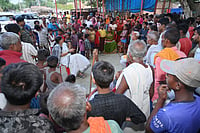It is noon on a Sunday at Punaura Dham, a Hindu pilgrimage site in Sitamarhi district of Mithila, Bihar. Women are sitting in groups around a lota (metal pot) and flowers, bananas and incense, murmuring religious hymns. They are performing Jitiya/Jivitputrika puja in the Punaura Dham quadrangle. Jitiya, celebrated in Bihar and Nepal, is a festival in which women pray for the well-being of their children.
About 150 km from Bihar’s capital Patna, Punaura Dham is the fabled birthplace of Sita. In these parts, people fondly call her Janaki, Maithili, Vaidehi, etc. The dham is now part of the new-age Ramayana circuit. Sitamarhi was carved out of Muzaffarpur in 1974. It’s far from the chaos of the city and the usual temple crowd. Every few minutes, devotees come, pray, take prasad from the purohit and leave.
According to the epic, it was in Punaura where King Janak of Videha—surrounded by Sadanira (Gandaki river), Kaushiki (Kosi river), Ganga and the Himalayas—was ploughing land, when he found the infant Sita under the soil. Spread over a large area, Punaura Dham has a well-maintained temple, pond, garden and samadhis of mahants who have served the temple in the past. Locals say the pond is where Sita was found.
ALSO READ: Who Is Ram And What Is His Story?
Along with Sita, there are idols of Ram, Lakshman and other deities in the temple, but for locals, it is a temple dedicated to Sita. On loudspeakers, the chant, “Sita-Ram, Sita-Ram…” plays on loop.
That an idol of Ram is also present in the temple next to Sita’s, is a mere coincidence. Its testimony comes from the story of the dham’s emergence as a pilgrimage site, which began in the 16th century.
Mahant in-charge Kaushal Kishore, 75, who has been living here since he was 10, recalls the myth about the place. “A mahant called Asharam from Lucknow had come here in the early 16th century. On hearing that Sita was born here, he started worshipping here. One day, a person carrying idols of Ram, Sita and other gods was passing by on a bullock cart. Asharam liked the idols of Ram and Sita and asked the driver to give them to him, but he refused, as he had to deliver them to someone else.” He had just moved a few metres when his cart broke down. Seeing this as a divine sign, he gave all the idols to the mahant. Asharam installed them here. Over time, the temple came up.”

While across the country, right-wing organisations are trying to polarise Hindu voters using Ram, for people of Mithila, and especially Sitamarhi and adjoining districts, Sita reigns supreme.
ALSO READ: Growing Up With Ram And His Epic Story
In Punaura Dham too, there are no other traces of Ram. The chant playing on loop at the temple mentions Sita before Ram. A Janaki stuti (prayer) on paper hangs on a temple wall. “People come here to worship Sita. She is so close to the people of these parts that they have no idea this temple also has an idol of Ram,” says a purohit. “For youngsters, Sita is sister. For older women, she’s a daughter. Ram is the brother-in-law or son-in-law, not the mighty king whose name is nowadays proclaimed with clenched fists and red eyes,” he adds.
Shops have mushroomed near the dham of late, but business remains thin. Only a few festivals attract good business. A shopkeeper says, “All across, people are more attracted to Ram than Sita. Visitors to this temple are mostly locals.”
“Ram is not a warrior for us. He is a son-in-law whom we rightfully abuse,” says a middle-aged woman, with a blush. She was preparing for Jitiya puja with her 14-year-old daughter.
Suresh Sharma, a purohit, says, “Ram may be a fierce king for Ayodhya, but to us, he is just a groom. It is because of Sita that he never killed anyone in Mithila. The only time he picked up a bow here was at the swayamvara to win Sita.”
In traditional Maithili songs, Ram is mocked and abused. Beena Jha, a resident of Sitamarhi, sings these with enthusiasm. The opening lines of one such song goes: “Pratham katha ki pucchhiyan sakhi he, Raghukul ki gati nyari he/Kheer khaye baalak janmaulan, Awadhpuri ke nari he (Never before hearing the strange story of the Raghu dynasty, Have I heard of women getting pregnant by eating kheer, as in Awadh).”

According to the Ramayana, King Dasharath had performed a yagna to bear children. A pleased Agni (God of Fire) gave him kheer to be distributed among his three wives—Kaushalya, Kaikeyi and Sumitra. After having the kheer, Kaushalya gave birth to Ram, Kaikeyi to Bharat and Sumitra to Lakshman and Shatrughna.
In another couplet, she mocks Ram for one of his descendants fathering 60,000 children with a single wife. The story behind this is about King Sagar, a descendant of Ram, whose wife Sumati bore him 60,000 children, all of whom died.
Laxmi Devi of Punaura expresses anger at Ram for abandoning Sita when she was pregnant. “He abandoned her to pacify his subjects. She had to suffer even though she was blameless. He should have believed in Sita, as she was his wife,” she says.
Every year, after Ram Navami, Sitamarhi celebrates Sita Navami, in which a wedding procession arrives from Ayodhya. Women welcome it with songs mocking Ram. “For us, Ram is like any other groom we abuse at weddings,” says Devi. But unlike Ram Navami processions accompanied by men bearing arms and aggressively chanting slogans, Sita Navami is a cultural event for women.
While Ram is imagined as a son-in-law, Sita has many avatars. Since she was abandoned by Ram, locals avoid naming daughters after her, believing it brings bad luck. Also, weddings are not held in Aghan (November), when Sita was married. “We avoid giving daughters in marriage during Aghan, as we believe it will bring misfortune,” says Devi.
Yet, Sita is also seen as a strong woman. According to the epic, Sita was so powerful that she could lift Shiva’s bow with her left hand. Seeing this, King Janak organised her swayamvara with the hope of finding a groom who would be more powerful than her, on condition that the winner would not only have to lift Shiva’s bow, but also break it.

In Mithila paintings, although Ram carries a bow, both his and Sita’s faces are expressionless. “The style of Mithila paintings leaves no space for emotions,” says Mithila artist Shalini Karn.
Anoop Maithil, who is agitating for a separate Mithila state, says, “Janaki Mata or Sita is the most unique example of women’s empowerment, but she isn’t promoted properly. Instead, she’s depicted as weak. Unlike Sita, today’s women are self-sufficient and educated, but when their husbands abandon them, they demand alimony.”
ALSO READ: Asura: The Last Words Uttered By Ravan
“Despite being a princess, she lived in a forest, where she cut wood to feed herself and her children. She made Luv and Kush so adept in war that together, they beat Ram’s army. We want this image of hers to be promoted and a Central Women’s University established in her name,” he says.
Barely 2 km from Punaura Dham is another Sita temple in Sitamarhi’s marketplace, called Janaki Mandir. According to mythology, a ritual was performed at this place on the seventh day after Sita’s birth. Here too, there are idols of Ram and Sita, but people come to worship Sita.
It is believed that Birbal Das, an ascetic from Ayodhya, came here on hearing of this temple and stayed back. Mahant Triloki Das of the temple informs, “Janaki Mandir was built during the time of Darbhanga Maharaj.”
ALSO READ: Ram As Purabiya’s Own Family Man
Uniquely, this temple has a statue of Mahatma Gandhi, and unlike the usual iconography, it comes without his spectacles and stick. Made of white stone, Gandhi is seen sitting with folded hands. Below it is written his favourite hymn “Raghupati Raghava Raja Ram, Patita Pavana Sita Ram”.
The statue is so unlike the usual ones of Gandhi that many devotees fail to recognise him, making offerings to the idol of flowers and tika on the forehead. No one is sure why and when the statue was installed.
Politics over Ram
For Bihar, 1990 was a turning point. On October 23, then CM Lalu Prasad Yadav halted the Rath Yatra of BJP leader L.K. Advani—meant to polarise Hindu voters in the name of Ram and the Ram Temple—in Samastipur, and had him arrested.
A year before that, in 1989, Bhagalpur had witnessed the worst communal riots in Bihar’s history. It had started with a Ramsheela procession.
In his biography, Gopalganj to Raisina-My Political Journey, Lalu wrote that the Rath Yatra threatened to return Bihar to 1989. Since then, the BJP has been trying to extract votes in Ram’s name. It’s yet to form a government alone, though vote shares and seats indicate the party has increased its base with every assembly election.
In 1995, the BJP had just 7.54 per cent vote share in Bihar, which increased to 19.46 per cent in 2020. It indicates that while politics over Ram does improve the BJP’s prospects in Bihar, it’s not as sweeping as in Uttar Pradesh. Analysts believe that in Bihar, caste is still more important than Hindutva.
Chandan, a senior Patna-based journalist, says, “In Bihar, caste is still above religion, especially for the marginalised. Secondly, in UP, the Ram temple movement had a bigger impact on people’s minds as it went on for a long time, unlike in Bihar, where the movement almost petered out with the arrest of Advani.”
“Caste consciousness is stronger in Bihar than in UP because of the memories of the 90s, when Bihar faced gruesome caste violence,” he adds.
Perhaps, the BJP’s image in Bihar as an upper caste party is also a factor. “Leaders of OBC and other backward castes have emerged only recently,” he says. “That’s why BJP still needs an ally.”
Interestingly, BJP leaders never promoted Sita in Bihar. They tried to disassociate her from Ram and popularised the Jai Sri Ram slogan. Sitamarhi locals expressed disappointment with the central government for not promoting Sita with the same vigour as it does for Ram. Chandan says, “If the BJP had promoted Sita, they would have got women’s votes easily, because women of Bihar, especially north Bihar, are emotionally attached to Sita.”
Instead, the BJP is seen leveraging caste, hatred against minorities, and Ram, to increase its vote share. It has started promoting backward community leaders in the state unit, and has renewed targeting Muslims in Seemanchal, with Union home minister Amit Shah addressing his first rally since the 2020 state assembly polls in Purnia.
The party has also increased its religious activities. Ram Navami is celebrated on a large scale, with an increased presence of swords and other weapons. Communal violence, too, has increased. Around 117 incidents of communal riots were reported in Bihar in 2020, the highest among 28 states according to the National Crime Records Bureau (NCRB). In 2019, the state had reported 135 such cases. Though the numbers fell by over 50 per cent in 2021, Bihar remains vulnerable to the politics of hate.
“Bihar used to be a land of socialist movements, with socialist leaders helming the state for over two decades. That’s why communal politics hasn’t yet succeeded in Bihar,” says political analyst Mahendra Suman. “But I’m not sure if this will hold in the coming years. Since 2009-10, the BJP and the RSS have increased their activities in Bihar, and after the BJP’s landslide victory in the 2014 General Elections, the scenario changed quite a lot,” Suman adds.
(This appeared in the print edition as "An Honoured Guest at Sita’s Home")
(Views expressed are personal)
Umesh Kumar Ray is a freelance journalist



























